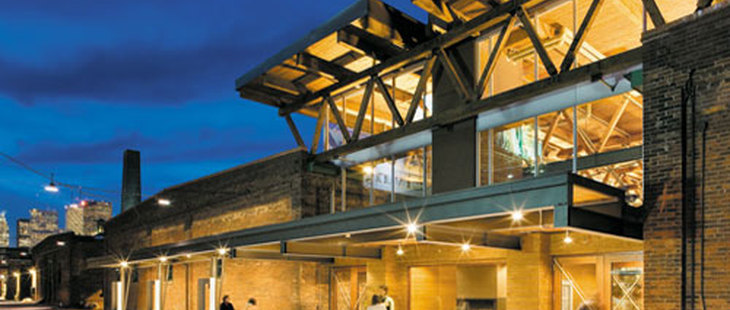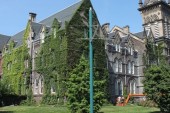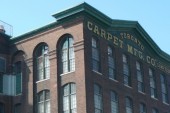

The Heritage Toronto Awards are a little odd. The 37-year-old awards, the latest of which were handed out Tuesday night, play quite loosely with the definition of “heritage.”
Though no books warranted the Award of Excellence this year, of the three that got Awards of Merit, the three Honourable Mentions and the five “other nominees” named, only five seem to “explore Toronto’s archaeological, built, cultural and/or natural heritage and history,” as the city-run organization’s site says they should.
But congratulations to them, I’m sure they’re all fine books. And I’m sure the formerly Art Deco house at 16 Glen Edyth Place renovated into stark modularity, and the French Quarter-inspired verandahs stuck on the back of 461 King East were all very well executed. And if “heritage” is taken to mean “stuff the jury thinks is nifty,” then it’s all quite proper and consistent and I’ll have nothing more to say on the matter.
But they also honoured Paul Oberman. And that evens things out nicely.
You’d be forgiven for not knowing who he was, and I don’t plan on writing an encomium to him here. I interviewed him a couple of times a year ago, a few months before he died in a plane crash in March at the age of 53.
Oberman was the man behind Woodcliffe Properties, the company that restored North Toronto Station, popularly known as the best liquor store ever. He also bought and renovated the Gooderham building, better known as our Flatiron, and the Five Thieves, now more properly known as the Shops at Scrivener Square. At his death, he was also working on a reboot of Market Street, the street that runs along the eastern side of St. Lawrence Market, once home to great old-time bar The Fish Market, but for at least a decade now a dead zone in the middle of one of the city’s most vibrant neighbourhoods. He was working on a huge expansion of the tiny LCBO at the corner of Front, and the establishment of flower shops, cafes and other life-giving retail to the little street, with hopes of getting the city to make it pedestrian only.
The kind of work Oberman did is known as adaptive reuse, and its widespread practice here sets Toronto apart from most cities in the world in its ability to not only incorporate old into new—most European cities do that fairly well—but have the new structurally, aesthetically influence the old without fundamentally compromising either. The Tate Modern is a gorgeous example of adaptive reuse in London, but it stands out in that city as an anomaly. In Toronto, it’s fast becoming the norm. It’s an approach to architecture and development that requires vision, dedication, patience, and a lot of money. Lucky for us, Oberman had all four in apparent abundance. Even luckier, so do a bunch of others.
Like Cityscape, who worked with Architects Alliance and others to give us the Distillery District. Or Lanterra and Quadrangle who did some great work on Liberty Village’s Toy Factory, including mocking up a new water tower when the old one tipped over and broke.
We’ve been maintaining faades for a while: the Design Exchange is a prime example. But it didn’t take long before people in the building industries started to realize that vestigialism wasn’t enough. It maintains an aspect of a familiar streetscape, and evidence of various architectural details, but these disembodied fronts end up, once the excitement of preservation is spent, nothing more than snapshots in a scrapbook.
So now, we’ve got James Cooper Mansion, a full Victorian manor house on Sherbourne incorporated into a 32-storey condo tower, a little like Calatrava’s Allen Lambert Galleria in Brookfield (n BCE) Place.
The much-maligned ’50s and ’60s, when cities ploughed their old buildings in favour of shiny new towers and slabs, was, whatever you think of the results, a profoundly optimistic time. The belief underlying all that ploughing then was that the new things we were building were better than the stuff we built 50 and 100 years previous. They had enough confidence in the present to offer it up to the future as preferable to the past. What followed, in more recent decades, was a violent swing in the opposite direction towards a culture of preservation at any cost. If a building is 100 years old, it should be retained by definition, and in as pristine a form as possible. Though commercial concerns kept this from completely taking over in Toronto, it’s a fundamentally pessimistic strain running underneath much of the development discussion in this city, and it’s the fuel that fires the mostly conservative neighbourhood associations that are open to anything as long as it’s exactly the same as it ever was.
Adaptive reuse is an admirable hybrid of the two inclinations. The old buildings are retained, along with their structural and aesthetic integrity, and their relationship to the street, which is the only level people actually experience a city on. At the same time, in the best examples, the practice acknowledges evolution, technological, aesthetic and demographic.
You could call it the thinking businessman’s approach to urban preservation. Oberman, for one, always seemed to be able to make money out of the process, no matter how costly and involved. He was a rich man, and enjoyed making money. But he liked old buildings, too, and in an object lesson to money-makers everywhere, figured out a way to make the two things compatible.
I’ll leave you with one of the last things he said to me, after we’d talked about the specifics of his various projects, when I asked him for his thoughts on the kind of work he did.
“We always strive to maintain the integrity of the buildings whose lives we’re passing through,” he said, “to protect and preserve the building for future generations.”
That’s some heritage for you.
__
Bert Archer is Toronto Standard’s Media Critic but also writes occasionally on architecture and urban development.














